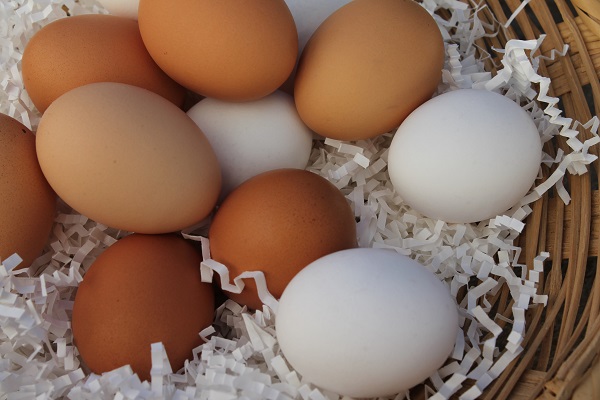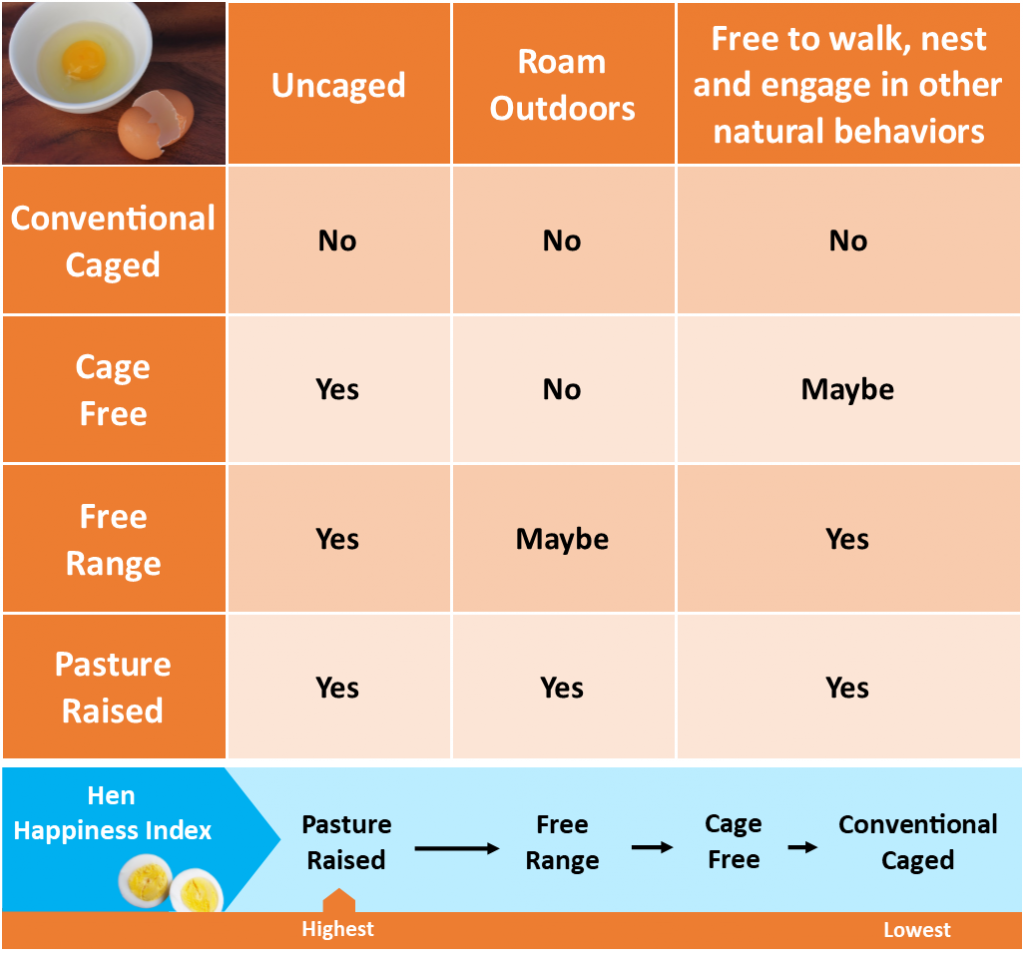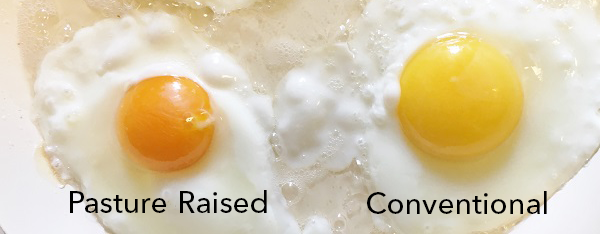The egg aisle is a confusing place! The egg cartons are plastered with pictures of happy chickens and seemingly healthy terms like farm fresh, natural, organic, free range, and cage free. So many options can make your head spin! How do you decide which one to buy? Let’s dig a little deeper and crack the confusion on what the egg carton labels really mean!
Eggstra! Eggstra! Learn All About Egg Labels!
Egg carton labels can be grouped into two general categories: what the hens were fed and how they were raised. It’s important to pay attention to both of these categories because how the hen was raised AND what it ate both play a huge role in the nutrient density and fatty acid profile of the eggs produced.
Eggstra! Eggstra! Pay attention to egg labels regarding what the hens were fed AND how they were raised #saslife Click To TweetLet’s look closer at both categories to decipher what the terms actually mean, which ones are worth the extra money and which ones are simply a marketing ploy.
What They’re Fed
The old saying “you are what you eat” not only applies to the food you consume but also to what your food consumes! Here are a few common claims seen on egg cartons along with their actual meaning.
Natural
- There is no set definition or regulation of the term ‘natural’ so it’s basically meaningless.
Vegetarian Diet
- Chickens aren’t vegetarians, they’re omnivores!
- In nature, chickens get most of their protein from worms and insects so when they’re fed a vegetarian diet composed primarily of corn and soy (most of which is genetically modified-GMO), it’s not their natural diet.1
Organic
- This claim is USDA regulated and very specific.
- Organic eggs must come from free range hens (definition below) with access to the outdoors, fed organic feed (no synthetic pesticides) and receive no hormones or antibiotics. 1
- However, other than ensuring the birds have access to the outdoors, this label has little to do with how the animal was actually raised. You can have organic eggs that come from hens raised on factory farms that never see the light of day AND from hens allowed to roam and forage in their natural habitat.
How They’re Raised
Commercial egg producers provide hens with varying degrees of space to roam anywhere from the size of an iPad to a one-car garage. Look to the labels to help determine how much room Nellie actually had to roam.
Some of the labels described below are regulated by the USDA and others are not. Regardless, it’s best when matched with a 3rd party auditors seal such as Certified Humane, Animal Welfare Approved, Humane Farm Animal Care (HFAC) or American Humane Certified so look for these seals on your egg carton.
Conventional Caged
- Standard supermarket eggs.
- According to the Coalition for Sustainable Egg Supply, 95% of eggs produced in the US come from hens raised in battery cages. These cages house 4 to 12 birds, giving each about 67 square inches of floor space (equivalent in size to an iPad), and they are not given access to the outdoors. These cages are often stacked in rows in industrial-sized barns housing thousands of birds.1
- If you don’t see any of the terms below on the egg carton, assume you have a conventional egg.
Cage Free
- Hens don’t live in cages.
- They can walk around in a building, room or open area, usually an industrial-sized barn or poultry house, and are provided nest space and perches.1
- However, conditions are cramped, to say the least, with only 1-1.5 square foot of floor space per hen.2
Free Range
- Hens have access to outdoors and are allowed to forage for plants and insects when outdoors. They are also provided floor space, nesting space and perches. 1
- Access is the key word here and it doesn’t guarantee the hens ever actually stepped foot outside, just that they had a way to do so (often nothing more than a few small doors leading to a screened-in porch with cement, dirt or a small plot of grass). In fact, given the less than desirable conditions of many commercial egg facilities, a vast majority of hens never actually go outside. 1
- To be free range and certified humane, there must be a minimum of 2 square feet of outdoor space per bird. 2
Pasture Raised
- Hens spend most of their lives outdoors with a fair amount of space plus access to a barn. They can eat worms, insects and grass (their natural diet!), along with supplemental feed (may or may not be organic unless it’s also certified organic). 1
- The USDA does not recognize a labeling definition for pastured eggs. However, the HFAC has developed a detailed set of animal welfare guidelines to help regulate this claim. Look for their Certified Human Seal in conjunction with the pastured raised claim on your egg carton.2
- The amount of space the hens actually get depends on the farm. Look for the square footage per bird listed on the carton and/or the HFAC seal which guarantees at least 108 square feet of space per bird.
- Check out this interactive visual from Vital Farms for more information on pasture rotation.
Nutrition Content of Conventional vs Pasture Raised Eggs
The exposure to sunlight and fresh air pasture raised hens experience contribute to overall healthier flocks and more nutritious eggs. Compared to the eggs of conventional caged hens, pasture raised eggs have:
- 2x as much vitamin E
- 2x as much long-chain omega-3 fats
- 5x more omega-3 fatty acids
- 38% more vitamin A
- Less than half the ratio of omega-6: omega-3 fatty acids. 3
A study done by Mother Earth News also found similar results.
Does Color Make a Difference?
The color of the egg shell doesn’t determine its nutritional value and is based simply on the breed of the bird. So buy any color egg your heart desires- white, brown, blue, etc.!
The color of the egg yolk, however, is an indirect indicator of nutritional value and is determined by what the hen eats. The nutrients from more pigmented food (like green plants and insects) pastured hens consume are concentrated in the yolks, giving the yolks a darker orange color and a greater nutritional value.
The color varies throughout the year as what the hens are foraging changes with the seasons. For example, you may find more yellow, conventional-looking yolks in the colder months when feed supplementation is often higher due to lack of vegetation. In comparison, conventional caged hens are fed a vegetarian diet of corn and soy and don’t have the opportunity to “eat off the land”…hence the brighter yellow hue.
Where to Purchase
Pasture raised eggs aren’t in every supermarket like conventional eggs, but they’re getting easier to find! A great place to start is your local farmers markets. There are tons of great small farms that do an EGG-cellent job taking care of their animals (pun totally intended!).
In the grocery store, pay close attention to the labels on the cartons to make sure you’re getting the real thing. Don’t fall prey to those pictures of happy little chickens frolicking on the farm without reputable claims to back their nutritional value and standards of care! Stick with organic pastured raised or pasture raised whenever possible and remember to also look for the humane seal and/or information on the amount of square foot per bird.
A few brands that can be found in stores in the Cary/Raleigh, North Carolina area include Vital Farms, NestFresh, and Handsome Brook Farm (just to list a few).
Take Home Message
No egg is “bad” but when it comes to nutrient density and fatty acid profile, the golden egg goes to pastured raised eggs! Choose pastured raised whenever possible as it most closely replicates the chickens’ natural environment. And get organic when possible to ensure the feed they’re given is also clean (or talk to your local farmer who is likely providing organic feed just without the certification).
In case your first choice isn’t available, use this guide to decide which egg to buy: Organic Pasture Raised > Pasture Raised > Organic > Free Range > Cage Free > Conventional.
Remember, it’s not just what we eat that matters, what our food eats also matters! And if you’re interested in learning more about grass fed beef (similar standards, different animal), check out is grass fed worth it.
Sources:
1. National Public Radio
2. Huffington Post
3. Renewable Agriculture and Food Systems
Homemade Mayo
Makes 1½ cups
Recipe From: The Healthy Foodie
Ingredients

1 whole fresh large or extra-large egg
1 cup extra light tasting olive oil or avocado oil
2-3 tsp fresh lime or lemon juice or vinegar of your choice
¼ tsp sea salt
1 Tbsp Dijon mustard (optional)
Optional Add-Ins:
¼ tsp freshly ground black pepper
1 garlic clove, peeled and coarsely chopped
Directions
- Allow all ingredients to come to room temperature.
- Add all the ingredients to a tall, narrow, one pint wide mouth mason type jar and let sit for a few seconds, just long enough for the egg to settle comfortably at the bottom of the jar, underneath the oil.
- Insert an immersion blender and push it all the way down until it makes contact with the bottom of the jar.
- Push the power button and do not move the blender for a full 20 seconds. The oil will start to emulsify and turn into this lusciously creamy and thick concoction, slowly making its way all the way to the top of the jar.
- Move the blender around and up and down after that first 20 seconds to make sure every last bit of oil gets well incorporated.
- Store in the refrigerator in an airtight container for up to 2 weeks.







